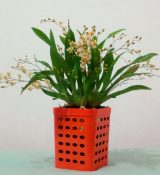Orchid Plant Blooming Overview
Author: admin3 Comments
Orchid Plant and Flower Blooming Information Overview
The key to getting an orchid plant to bloom all year long lies in choosing an orchid that’s best suited to the conditions in your home. Below is some basic background on different types of orchids and the factors that influence their bloom and growth.
Growing Epiphytic & Terrestrial Orchids
There are two basic categories of orchids. Those that grow in trees are called epiphytic orchids. Those that grow on the ground or close to it are called terrestrial orchids. One very popular orchid is the Phaleanopsis. These orchids are typically potted with their roots in a course, quick-draining medium to mimic the conditions in which it would thrive when growing on tree bark. The quick-draining character of the soil helps replicate the conditions of the short but heavy rains that occur in tropical forests. Terrestrial orchids like the slipper orchid, on the other hand, are potted in a medium similar to ordinary potting soil.
Orchid Growing Temperatures
Another factor to consider when blooming orchid plants is the room temperature.As stated above, one key to successful bloom and growth of orchids is selection of species that are well suited to the temperature range in your home or office.
- Calia orchids are a popular variety that thrive best in warm temperatures. Consider selecting this warm-growing orchid if you plan to be placing it in a warm room.
- Phaleanopsis orchids are an intermediate-growing orchid, and will do well in rooms that stay in the 70-degree range, and that have a slight temperature drop at night.
- The jewel orchid is a cool-growing orchid that does best in an area that stays 70 degrees or below, and one without bright, direct sunlight.
Growing orchid plants is a fascinating pursuit, whether you are interested on a commercial level or simply as a hobby. There are, of course, thousands of different orchid plants, many of which have specific needs particular th their species. Below we have listed many of the most popular orchid plant species and specific growing techniques suitable for each type.
- Cattleyas
- Cymbidiums
- Dendrobium Phalaenopsis
- Nobile Dendrobiums
- Equitant Oncidiums
- Masdevallias
- Miltoniopsis (Miltonias)
- Oncidiums
- Paphiopedilums
- Phalaenopsis
- Phragmipediums
- Vandas
Other Useful Orchid Blooming Tips & Techniques
Repotting Orchids
There are several different ways to repot an orchid plant, and different orchid varieties can require different repotting techniques and potting materials.
- If you purchase an epiphytic orchid like a Phaleanopsis, chances are good that the plant has been growing in the same pot for some time. The medium may have begun to decompose and lose its quick-draining characteristics. As soon as you get the orchid home, it’s a good idea to repot it, replace the old medium with new, and condition the roots.
- Carefully lift the orchid out of its pot. Most of the growing medium should simply fall away from the roots. You may need to gently shake any remaining medium free.
- With most of the old medium removed, carefully examine the roots. Use scissors to clip away any dead roots. Leave the white, healthy roots intact. If any of those have unhealthy or dead tips, trim away the unhealthy portion. The trimmed roots should regenerate healthy tips.
- Orchid pots come in a variety of styles, but most are designed with multiple holes in the sides to allow rapid soil drainage. We opted to pot ours in a clear glass pot that allows the root system to remain partially visible.
- The ideal medium for these epiphytic orchids contains large pieces of bark and charcoal to accommodate good drainage. Orchid-potting medium is available at nurseries and most home centers. (If you’re potting a terrestrial species, be sure to use a potting medium formulated for terrestrial orchids).
- Place a layer of the medium in the bottom of the container. Then carefully hold the orchid in the pot as you add more medium around the roots. Add the medium uniformly around the roots so that the orchid stands up straight in the pot.
- If the roots of your orchid begin to grow and cascade over the edge of the pot, it’s not necessarily a sign that the plant needs to be repotted. The roots of epiphytic species, in particular, may tend to grow along the surface of the medium — as they would on tree bark in their natural surroundings. When you do re-pot, you may want to keep these interesting-looking root formations intact when you place the plant in its new container.
Watering Orchids
- The proper technique for watering orchids once again attempts to mimic their natural growing conditions. For our epiphytic species, we lower the entire orchid pot into a container of water to completely immerse the roots and growing medium. Once the medium is well soaked, lift the pot out and allow the excess water to run off. This approximates the conditions of a hard, tropical rainfall.
- Orchids thrive well with a lot of humidity around their leaves and flowers. Use a plant mister to mist the orchid periodically. Avoid misting orchids late in the day. Leaving the plants moist overnight can allow fungus to begin growing and rot to occur. For best results, mist orchids between 8 am and 1 pm so that they have a chance to dry before nightfall.
Orchid Fertilizer
- To stay looking their best, potted orchids generally require two kinds of fertilizer: a high-nitrogen type and a high-phosphorous type. The high-phosphorous fertilizer gives the plant the energy it needs to grow new blooms and flowers. With some experience at growing orchids, you’ll learn the best ways to alternate these two types of plant-food to achieve the best results.
3 Responses to “Orchid Plant Blooming Overview”
Leave a Reply


Ask an Expert
Questions about orchids?
Our experts love a challenge!
Photo of the Week
Submit your photo to be featured on the blog!
More Photo of the Week Winners
Submit Photo








I got my first orchid last year and I’m not sure what species it is. It bloomed nicely for about 4 months and hasn’t bloomed since. Do I need to cut off the stalks to encourage new blooms? Any help on getting my orchid to rebloom would be appreciated. Thanks
Jo,
I’m in the same boat as you. I have gotten 3 orchid gifts now 2 are not blooming any more. I’v heard different things. One lady Told me she has 5 orchids that are allmost allways in bloom and she does nothing. In fact she said she heardly remembers to water them. Then I heard from my niece that you need to cut them but only at a certain place…she didn’t know what place. If you ever get any info let me know OK.
Sheila
Received an orchid as a gift, when the blooms have fallen, do you keep watering???